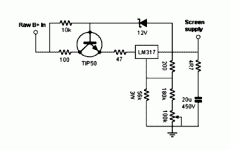Poobah, that's exactly right.
Crowhurst discusses this in detail in his book "Understanding Hifi Circuits." It may be easier to find his shorter treatment in the article, "Puzzled About Amplifiers?" from Audio in 1959.
Crowhurst discusses this in detail in his book "Understanding Hifi Circuits." It may be easier to find his shorter treatment in the article, "Puzzled About Amplifiers?" from Audio in 1959.
No, that's not the one, but I goofed and the article I cited wasn't, either; it was more relevant to the anti-blocking measures that I took.
The book citation is correct, however. And it's a book that anyone serious about tubes should own.
The book citation is correct, however. And it's a book that anyone serious about tubes should own.
I don't mean to get off track, but Pete Millett has some new scans, including some by Crowhurst.
The complete article on this amp has now appeared in Bas Horneman's diy magazine:
 Compromised URL removed by Moderation
Compromised URL removed by Moderation
 Compromised URL removed by Moderation
Compromised URL removed by Moderation
Last edited by a moderator:
Hi SY,
Your MJE340 is looking the wrong way in the HV regulator diagram. 😉
It's a well written article. Still reading.
-Chris
Your MJE340 is looking the wrong way in the HV regulator diagram. 😉
It's a well written article. Still reading.
-Chris
Just read the article Sy. Great writing!
With your writing style I imagine I could understand just about anything, even how the female mind works (or does'nt).
Thanks very much.
Andrew
With your writing style I imagine I could understand just about anything, even how the female mind works (or does'nt).
Thanks very much.
Andrew
I read the article too Stuart.
Aside from the usual compliments for the great work, I would like to know more about the issue of overload recovery.
A simple question for now: what do you think of driving a power tube (not extreme ones) in a PP with a cathode follower, dc coupled? Are there really advantages in DC coupling (assuming that I don't need necessary A2 drive)?
And if I drive power tubes with a cathode follower, would be cathode bias an option or would you consider only fixed bias? Leds are not applicable here because I would need an insane amount of them
Thank you very much.
Aside from the usual compliments for the great work, I would like to know more about the issue of overload recovery.
A simple question for now: what do you think of driving a power tube (not extreme ones) in a PP with a cathode follower, dc coupled? Are there really advantages in DC coupling (assuming that I don't need necessary A2 drive)?
And if I drive power tubes with a cathode follower, would be cathode bias an option or would you consider only fixed bias? Leds are not applicable here because I would need an insane amount of them

Thank you very much.
Walt, it needs some green LEDs for that use!
The CF is an optimal way to do it. Even if you don't push the output into grid current, you extend bandwidth and (if the CF is direct coupled) prevent blocking. It also allows triode operation. If cost and complexity are no object, that's the way I'd go.
what do you think of driving a power tube (not extreme ones) in a PP with a cathode follower, dc coupled? Are there really advantages in DC coupling (assuming that I don't need necessary A2 drive)?
The CF is an optimal way to do it. Even if you don't push the output into grid current, you extend bandwidth and (if the CF is direct coupled) prevent blocking. It also allows triode operation. If cost and complexity are no object, that's the way I'd go.
Hi SY,
My apologies to you. Your MJE340 in the high voltage section is pointing the correct way. I just looked at the diagram too quickly and expected the raw power feed from the right. 😉
The article was good reading.
The Christmas version has some green pilot lights around the power switch. It flashes during warm-up like a Counterpoint!
-Chris
My apologies to you. Your MJE340 in the high voltage section is pointing the correct way. I just looked at the diagram too quickly and expected the raw power feed from the right. 😉
The article was good reading.
The Christmas version has some green pilot lights around the power switch. It flashes during warm-up like a Counterpoint!

-Chris
Hi SY,
You probably did when you saw what it really was. I think a TIP50 is a better choice depending on power dissipation. I'm sure that's what you intended, the MJE340 is an alternate for the MPSU10 error amp.
-Chris
You probably did when you saw what it really was. I think a TIP50 is a better choice depending on power dissipation. I'm sure that's what you intended, the MJE340 is an alternate for the MPSU10 error amp.
-Chris
SY said:I coulda sworn it was a TIP 50...
TIP 50
Attachments
Hi Guys,
Yes I was.
I'm currently enjoying a nice vacation on a different planet.
Liquid lunch was included.
I think I'll turn in before I post any more nonsense. 😉
-Chris
Yes I was.
I'm currently enjoying a nice vacation on a different planet.
Liquid lunch was included.

I think I'll turn in before I post any more nonsense. 😉
-Chris
SY said:The complete article on this amp has now appeared in Bas Horneman's diy magazine:
Compromised URL removed by Moderation
Wow, thats a very impressive article.
Congrats Sy on a truely outstanding project!!
Now, somebody please PM me and explain the redlight symbols meaning? lol
Trout
Last edited by a moderator:
- Home
- Amplifiers
- Tubes / Valves
- The Red Light District - another PP EL84 amp
